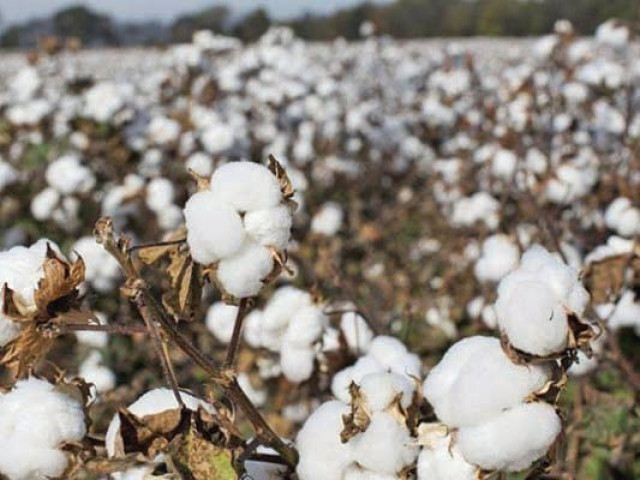Pakistan’s cotton yield 50% lower than region
Shrinking crop planting area sparks concern among policymakers

Pakistan is facing a sharp decline in cotton production as its per-acre yield has contracted to just half of the cotton productivity in regional countries.
Owing to thin profit margins for cotton planting, farmers have switched over to other crops like rice, maize and sugarcane. Economic policymakers have expressed serious concern over the constant decline in cotton production over the years.
In a recent meeting of the Economic Coordination Committee (ECC), the policymakers and Finance Minister Ishaq Dar observed that the cotton sowing area was shrinking, which was a cause of concern for the government. Dar, who chairs the ECC meetings, pointed out that the per-acre cotton production in regional countries was double the per-acre harvest in Pakistan.
It was emphasised that the Ministry of National Food Security and Research would look into developing a support price mechanism in consultation with the Ministry of Industries and Production.
The ECC noted that for the cotton support price, the wheat and sugarcane model might be considered.
Commerce Division secretary underlined the need for adopting international principles as well as undertaking a study on the comparative advantages of crops.
The Ministry of National Food Security recalled that the production of cotton, being the key crop in Pakistan’s agricultural economy, reached the high of 14.1 million bales in the 2004-05 season. However, in later years, its harvest averaged around 12 million bales while in the last four years, the output dropped to 7 million bales in 2020-21 and about 9.45 million bales in 2021-22.
Moreover, the unprecedented floods in 2022 significantly damaged the standing cotton crop, slashing overall production to a mere 4.76 million bales (according to cotton arrivals till March 3, 2023) against the target of 9 million bales.
The ministry stated that cotton production was decreasing and at the same time planting area was also shrinking. To meet the demand of textile industry, Pakistan has the potential to ramp up cotton production to 15 million bales in a short time span.
It was stated that the cotton price intervention policy during 2021-22 had resulted in price stability in the domestic market and higher investment in crop management, increasing production by 2 million bales despite a 7% decline in the cultivated area.
Similarly, the policy adopted in 2022-23 also ensured price stability in the domestic market. However, the unprecedented floods significantly damaged the standing crop.
The Ministry of National Food Security informed the ECC that in order to draw up a cotton intervention price proposal, consultations were held with all stakeholders including the provincial governments, growers and cotton associations in January and February 2023.
Growers proposed an intervention price of Rs7,000-8,000 per 40 kg.
Since the last consultation on February 10, 2023, the cost of inputs had further increased. The revised average cost of production “is now approximately Rs7,000 per 40 kg”, the food ministry said.
Stakeholders, including the All Pakistan Textile Mills Association, called for pegging the cotton intervention price with the import parity price in line with the policy adopted over the past two years. In a meeting convened at the Prime Minister’s Office on March 13, 2023, the ministry said that it was decided to submit a summary, proposing cotton intervention price of Rs8,500 per 40 kg, for ECC’s consideration.
It was emphasised that the announcement of intervention price ahead of the main sowing season would help growers decide on the planting area and investment in crop management. The proposed price was expected to help enhance yield and sowing area by 10-15%. The Ministry of National Food Security submitted following proposals for the ECC’s consideration and approval.
Fix cotton (phutti) intervention price at Rs8,500 per 40 kg.
Constitute a cotton price review committee with the mandate to review market prices and propose intervention on a fortnightly basis.
Provinces or the Trading Corporation of Pakistan (TCP) should procure cotton lint (base grade-III with staple length of 1-1/32”) from the pre-selected ginning factories.
ECC should advise TCP or provinces when to sell the procured cotton after assessing the local and international markets. Regularly monitor cotton prices in the main markets of Punjab and Sindh as well as in the international market and issue a brief price report at weekly intervals.
When domestic prices of cotton (phutti) drop below the threshold of Rs8,500 per 40 kg, trigger the intervention price at a 10% discount to the estimated import parity price.
The ECC considered the summary titled “Cotton Intervention Price for 2023-24 Crop”, submitted by the Ministry of National Food Security, and decided to set cotton (phutti) intervention price at Rs8,500 per 40 kg for the current crop.
It also constituted a cotton price review committee with the mandate to review market prices and propose intervention on a fortnightly basis.
The committee will regularly monitor cotton prices in the main markets of Punjab and Sindh as well as in the international market and issue a brief report at weekly intervals.
The ECC directed the Ministry of National Food Security to present a report on the deliberations held by the price review committee at the end of each month.
Published in The Express Tribune, March 24th, 2023.
Like Business on Facebook, follow @TribuneBiz on Twitter to stay informed and join in the conversation.



















COMMENTS
Comments are moderated and generally will be posted if they are on-topic and not abusive.
For more information, please see our Comments FAQ